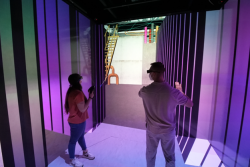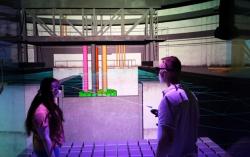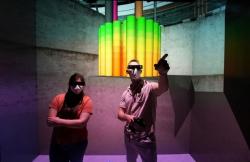Fuel for Thought
Real-time Analysis for Particle-transport and In-situ Detection (RAPID) Code System, a simulation platform that allows users to interact with nuclear technology and collaborate with colleagues through both Web3D and a high-resolution multi-user virtual reality (VR) interface using the X3D Standard.
Challenge 


Upheavals in energy markets have brought increased attention to nuclear power as a long-term, low-carbon domestic energy source, but the ability to safely store spent nuclear fuel is a key priority if nuclear power is to play a larger role in our energy future.
Solution
Virginia Tech researchers Alireza Haghighat and Valerio Mascolino have created the Real-time Analysis for Particle-transport and In-situ Detection (RAPID) Code System,a simulation platform that allows users to interact with nuclear technology and collaborate with colleagues through both Web3D and a high-resolution multi-user virtual reality (VR) interface using the X3D Standard. The system is designed to help engineers optimize the safety of spent-fuel storage across a variety of containers, assemblies, and configurations, and it has also proven valuable as a teaching tool. This image shows nuclear engineering students working with the simulation to examine how different designs affect the fate and security of spent fuel inside the high-resolution virtual reality room managed by Virginia Tech Advanced Research Computing.
Here, students in the Virginia Tech Nuclear Engineering program examine spent-fuel simulation scenarios in VT’s high-resolution Virtual Reality (VR) room. The RAPID simulation platform uses Monte Carlo methods to model particle transport and optimize the safety of spent-fuel storage across a variety of containers, assemblies, and configurations. Web-based interfaces and VR interactions by VT’s Advanced Research Computing (ARC) increase the accessibility of simulations and results.
Contributors
Alireza Haghighat and Valerio Mascolino, Nathan Roskoff, Nicholas Polys, Srijith Rajamohan
Photos by Alex Parrish.
Dr. Polys’ collaboration with Dr. Ali Haghighat, head of the Nuclear Engineering Program is featured in the 2023 Annual Brochure of the Coalition for Academic Scientific Computation (CASC - (p. 17)); this is the Visionarium Lab’s 5th appearance!



